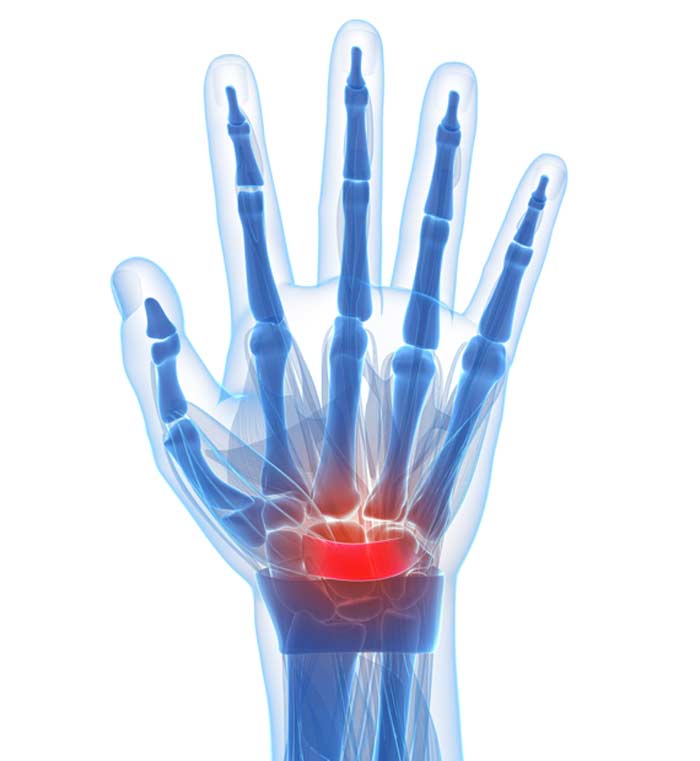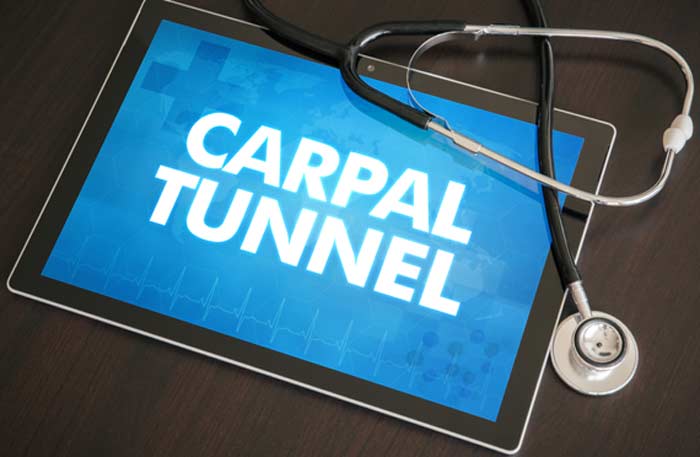
Carpal tunnel syndrome affects a narrow passageway in the wrist known as the carpal tunnel.
More common in women, carpal tunnel syndrome (CTS) is an irritation or compression of the median nerve that extends from the forearm into the palm.
While many people associate this condition with repetitive hand or wrist motions, it can also develop from an injury or damage caused by rheumatoid arthritis (RA) and other underlying health conditions that may affect circulation or trigger inflammation.
Causes and Risk Factors
The median nerve normally provides sensation to all of the fingers except for the little one and the palm-facing part of the thumb. If this nerve is compressed on a recurring basis or irritated, the result can be carpal tunnel syndrome. The carpal tunnel itself can also become narrowed as a result of a wrist fracture or a similar injury. Oftentimes, however, there is no one single cause of CTS. Indirect causes or risk factors associated with CPS may include:
- Having a smaller carpal tunnel
- Diabetes and other nerve-damaging conditions
- Excess body weight
- Fluid retention
- Thyroid disorders and certain other medical issues
- Workplace conditions (e.g., working with vibrating hand tools or on an assembly line)


Carpal Tunnel Syndrome Symptoms
Most cases of CPS begin slowly and progressively. Many sufferers first notice numbness or tingling sensations in certain fingers or one or both thumbs that comes and goes. Discomfort may also extend to the palm. As the condition progresses, the resulting pain may feel like minor electrical shocks. Some individuals with CPS may also feel tingling sensations or pain that travels from the wrist and extends up the arm. General weakness within the hand and wrist may also be experienced as the condition advances, which may lead to a tendency to drop items or lose a grip on objects.
Diagnosing CPS
Diagnosis usually starts with a discussion of symptoms and a physical exam of the affected area. Image tests may be performed to identify or rule out other possible sources of wrist or hand pain. Electrical signals from muscles may be measured with a test called an electromyogram (EMG). A similar test referred to as a nerve conduction study (NCS) may also be done to measure the electrical activities of nerves.
Treatment Options
Treatment of carpal tunnel syndrome sometimes begins with a recommendation to apply an ice pack to reduce swelling or perform hand/wrist stretches or exercises if discomfort is mild. Nighttime wrist splinting may be suggested if symptoms make it difficult to sleep. Some patients benefit from the wearing of a wrist brace or the use of ibuprofen and other anti-inflammatory drugs. Treatment could also involve:
- Corticosteroid injections directly into the affected wrist
- Separate treatments for arthritis, diabetes, and other conditions that may be contributing to CPS symptoms
- Endoscopic surgery to cut the ligament placing pressure on the median nerve (carpal tunnel release)
- Open surgery to relieve pressure on the median nerve
Even mild carpal tunnel syndrome symptoms can make it difficult to work or participate in favorite activities, sports, or hobbies. For this reason, it’s important to seek treatment as soon as possible. The repetitive strain that’s a common cause of CTS may be minimized by changing how certain handheld tools are gripped, taking periodic breaks from repetitive hand movements, doing gentle wrist and hand stretches, switching hands when performing certain tasks, and being mindful of hand and wrist posture.
